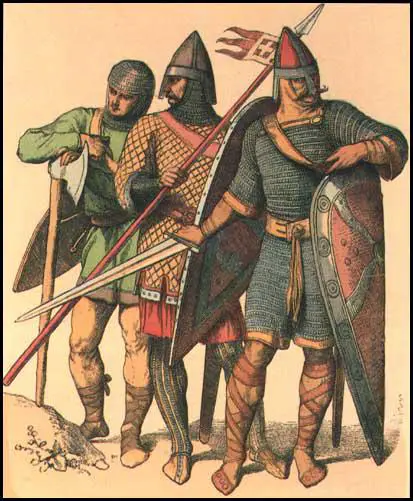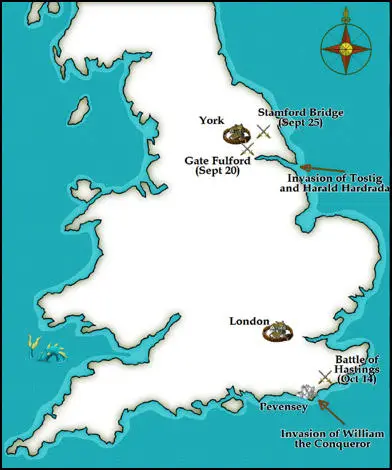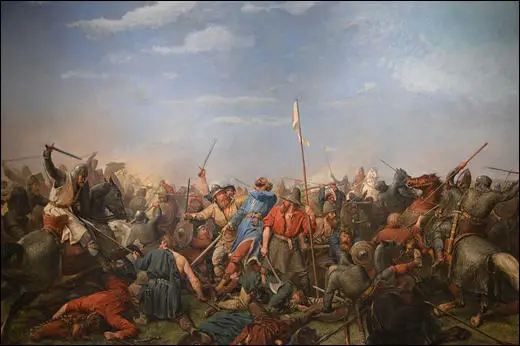The Battle of Stamford Bridge
In 1065 the Anglo-Saxon Chronicle reported that Tostig, the Earl of Northumbria, was guilty of robbing churches, depriving men of their lands and lives, and acting against the law. (1) In October, a group of rebels, supported by Earl Eadwine of Mercia and his brother Morcar, broke into Tostig's residence in York and killed those of his soldiers who did not escape. The rebels then nominated Morcar as their earl. Anyone associated with Tostig's regime was killed. (2)
When Edward the Confessor heard the news he called a meeting of his nobles at Britford. Several made complaints about Tostig's rule claiming that his desire for wealth had made him unduly severe. The king sent Tostig's brother, Harold, to put down the rebellion. Harold disagreed with this policy as he was convinced it would result in a disastrous civil war. At a meeting at Oxford on 28th October, Harold yielded to Edwin's demands. Tostig was banished from the country and Morcar, Harold's brother-in-law, became the new Earl of Northumbria. (3)
In 1065 Edward the Confessor became very ill. Harold claimed that Edward promised him the throne just before he died on 5th January, 1066. (4) The next day there was a meeting of the Witan to decide who would become the next king of England. The Witan was made up of a group of about sixty lords and bishops and they considered the merits of four main candidates: Harold, William of Normandy, Edgar Etheling and Harald Hardrada. On 6th January 1066, the Witan decided that Harold was to be the next king of England. (5)
Harold and Tostig
King Harold was fully aware that both King Hardrada of Norway and William of Normandy might try to take the throne from him. Harold recognised that his country was likely to be invaded both in the south and in the north. He visited York where he had meetings with Earl Eadwine of Mercia and Earl Morcar of Northumbria. He returned to London in time for Easter. (6)
Harold's brother Tostig, with a fleet of sixty ships, had attacked the Isle of Wight, occupied Sandwich, and then sailed up the east coast to the mouth of the Humber before being driven away by the Earl of Northumbria. Tostig now took refuge with Malcolm III, the King of the Scots in May, 1066. (7)
During this period he also made contact with William of Normandy. According to Frank McLynn, the author of 1066: The Year of The Three Battles (1999), the "steady military build-up did not suit the impatient Tostig, for soon he was off on a mission to find a ruler who would give him more immediate aid". He then went to see Svein Estrithson the king of Denmark. However, he told Tostig that he lacked the resources for an invasion. (8)

Harold believed that the Normans posed the main danger and he positioned his troops on the south coast of England. It was claimed by the Anglo-Saxon Chronicle that by June 1066 he had "gathered such a great naval force, and a land force also, as no other king in the land had gathered before." (9)
Harold placed his navy and some of the soldiers on the Isle of Wight. The rest of his soldiers were spread along the Sussex and Kent coast. "The object of this arrangement was that in the event of a landing the lookouts on the coast would signal the arrival of the enemy (probably by lighting a beacon) and Harold would then sail from the Isle of Wight with his army to fall upon the invaders". The reason for this is that the prevailing wind, particularly during the summer months, is from the south-west. "It was more than likely that the wind that would carry the invading fleet would be the same upon which Harold would sail, to land behind the invaders or on an adjacent beach." (10)
His soldiers were made up of housecarls and the fyrd. Housecarls were well-trained, full-time soldiers who were paid for their services. The fyrd were working men who were called up to fight for the king in times of danger. All earls had their own housecarls and Harold had a substantial force at his disposal. They were paid mercenaries and were equally adept in land and maritime warfare. (11)
Meanwhile, Tostig was negotiating with King Harald Hardrada about a possible invasion. Eventually the reached an agreement to attack Harold. After appointing his son, Magnus as regent he formed alliances with warriors from Iceland and Ireland. Tostig also convinced Hardrada that Harold was extremely unpopular in the north of England and that people living in this region would join them in their attempt to overthrow the king of England. (12)
Harold waited all summer but the Normans did not arrive. Never before had any of Harold's fyrd been away from their homes for so long. But the men's supplies had run out and they could not be kept away from their homes any longer. Members of the fyrd were also keen to harvest their own fields and so in the first week of September 1066, Harold sent them home. The sailing season was also drawing to a close for the year. Harold therefore decided to arrange for his navy to travel along the Thames to London to enable essential repairs to be carried out. Harold, after a short stay at his home in Bosham, rode to the capital with his housecarls. (13)
William's attack on England had been delayed. To make sure he had enough soldiers to defeat Harold, he asked the men of Poitou, Burgundy, Brittany and Flanders to help. William also arranged for soldiers from Germany, Denmark and Italy to join his army. In exchange for their services, William promised them a share of the land and wealth of England. William also had talks with Pope Alexander II in his campaign to gain the throne of England. These negotiations took all summer. William also had to arrange the building of the ships to take his large army to England. About 700 ships were ready to sail in August but William had to wait a further month for a change in the direction of the wind. (14)
Fulford Gate
In the first week of September, 1066, Hardrada's men raided Scarborough and slaughtered most of its inhabitants. Sailing on, the fleet entered the Humber estuary. Morcar, the Earl of Northumbria, and Eadwine, Earl of Mercia, were not willing to engage the enemy and retreated before him up the Ouse, before turning into the inland waters of the Wharfe to Tadcaster. Hardrada anchored at Riccall. After leaving a substantial force to guard the fleet, Hardrada, Tostig and about 6,000 men marched on York. (15)
On 20th September, Morcar and Edwin went into battle with Hardrada and Tostig at Fulford Gate. It has been estimated that the Norwegians had about 6,000 troops and the defenders 5,000. According to the Anglo-Saxon Chronicle "many of the English were slain, drowned or put to flight and the Northmen had possession of the place of slaughter". (16)
Other sources say casualties were high on both sides but it is clear that the invaders had a clear victory. (17) According to one source: "Trying to escape the pincer movement, the English veered away into the marsh, where they foundered in the bog until cut down or sucked into quicksands; those who tried flight on the other side mostly drowned in the Ouse. Soon the marsh and the ditches were clogged with human bodies, to the point where the Norwegians waded in blood and marched over the impacted corpses as if on a solid causeway." (18)
Stamford Bridge
Hardrada then moved onto York, which formally surrendered on 24th September. Hardrada took 150 children hostage from prominent families in Yorkshire as surety for their loyalty. Morcar and Edwin and the remnants of their army escaped into the countryside. The Norwegians now withdrew to Stamford Bridge, a place where several Roman roads met. The bridge would have been quite large by eleventh-century standards. (19)
It has been claimed that a messenger told Harold about the Norwegian victory at Fulford Gate he said that Hardrada had come to conquer all of England. Apparently Harold replied: "I will give him just six feet of English soil; or, since they say he is a tall man, I will give him seven feet." Harold then sent a summons for the men of the fyrd to reassemble, just days after they had been released from their long summer vigil. Having gathered as many of his men as he could he started for the north on about the 19th September. (20)

Harold and his English army had to travel from London to York. The 200 mile (320 km) journey usually took two weeks, or more depending if the roads were passable. (21) The historian, Frank McLynn, the author of 1066: The Year of The Three Battles (1999), has commented "the speed of his advance has always drawn superlatives from historians used to the ponderous pace of medieval warfare, but it may be that a good deal of his force was on horseback and that, as was the custom with Anglo-Saxon armies, they dismounted before fighting." (22)
Peter Rex argues in Harold II: The Doomed Saxon King (2005) that his housecarls were on horseback: "Such mounted infantry could manage twenty-five miles a day. They were also expected to have at least two horses, riding one and allowing the other to proceed unburdened. Harold no doubt could also expect, as king, to commandeer fresh horses along the way. If he did literally ride day and night he could have made Tadcaster in four days, although that would mean without sleep." (23)
On 25th September Harold's army arrived at Stamford Bridge. Harold and twenty of his housecarls rode up to the foot of the bridge on the left bank of the Derwent and had a meeting with Tostig. Harold promised his brother that if he changed sides he would be rewarded with the return of his earldom and one-third of all England. Tostig answered that it would never be said of him that he brought the king of Norway to England only to betray him. He turned on his horse and rode away. (24)
Tostig said they should retreat back to his boats. Hardrada rejected this as being unworthy of a Viking warrior. Aware he was outnumbered he sent a message to his men with his fleet at Ricall to come as soon as possible. He gave orders that his men should stop Harold's army from taking the bridge. "It is said that one particular giant of a man held the bridge single-handed, felling all his attackers with swings from his battleaxe. He was only defeated when he was stabbed from below by a man who was floated down the river under the bridge with a spear." (25)
Once Harold's men had crossed the bridge they engaged the enemy in hand-to-hand combat with swords and axes. The Norsemen were soon being "cut down in their hundreds". The shield-wall was breached and Hardrada was killed by an arrow in the windpipe. His men hesitated about what to do next. Tostig stepped forward and urged them to continue fighting. Tostig was also killed and the rest were forced into the River Derwent, where large numbers drowned. (26)

Harold and his men were left in possession of the battlefield for only a matter of minutes before the rest of the Viking army, fully armed and armoured, appeared on the scene. The Norwegians immediately delivered a ferocious charge which nearly succeeded in breaking the English, but Harold's army stood firm and by the end of the day, those Vikings still alive, under cover of darkness, retreated. Harold chased them back to Riccall. The twenty-year-old Olaf Haraldsson, now in command of the Norwegians, asked for a peace settlement. Harold agreed and allowed the Vikings to return home. The Norwegian losses were considerable. Of the 300 ships that arrived, less than 25 returned to Norway. (27)
Despite the victory, Harold had suffered heavy casualties and his army was severely depleted. However, the battle had shown Harold was a general of great talent. While celebrating his victory at a banquet in York, Harold heard that William of Normandy had landed at Pevensey Bay on 28th September. Harold's brother, Gyrth, offered to lead the army against William, pointing out that as king he should not risk the chance of being killed. "I have taken no oath and owe nothing to Count William". (28)
David Armine Howarth, the author of 1066: the Year of the Conquest (1981) argues that the suggestion was that while Gyrth did battle with William, "Harold should empty the whole of the countryside behind him, block the roads, burn the villages and destroy the food. So, even if Gyrth was beaten, William's army would starve in the wasted countryside as winter closed in and would be forced either to move upon London, where the rest of the English forces would be waiting, or return to their ships." (29)
Harold rejected the advice and immediately assembled the housecarls who had survived the fighting against Hardrada and marched south. Harold travelled at such a pace that many of his troops failed to keep up with him. When Harold arrived in London he waited for the local fyrd to assemble and for the troops of the earls of Mercia and Northumbria to arrive from the north. After five days they had not arrived and so Harold decided to head for the south coast without his northern troops. (30)
Primary Sources
(1) Arnold Blumberg, Too tired to fight? Harold Godwinson’s Saxon army on the march in 1066 (December 2013)
Many historians postulate that the Saxon army which encountered the Normans at Hastings was already greatly depleted by a forced march from the earlier Battle of Stamford Bridge in Yorkshire on 25 September 1066. Certainly King Harold’s Saxon army was having a busy autumn. Near the end of September they had marched the 200 miles (320 km) from London to Yorkshire to repel the invading forces of the Viking ruler Harald Hardrada and his ally, the English king’s brother - turned traitor - Tostig. Then, at the end of the month, the Saxon King received the unpleasant tidings that Duke William had landed on the south coast of Britain. Turning his army about, Harold had no alternative but to march all the way back south in order to meet the new, but not unexpected, Norman threat. By contemporary Western standards this sounds like a tall order, and it is frequently argued that only the elite mounted Saxon housecarls would have been able to make the journey in time....
The lighting campaign Harold conducted in the north of England against the Norsemen of Harald Hardrada and Tostig was masterful in that it involved speed, surprise and overcoming very difficult terrain. Northern Britain in the mid-eleventh century was divided culturally and politically from the rest of the nation, and was generally left to its own devices. Hard to reach – only a few roads traversed the Humber Estuary and the bogs and swamps of Yorkshire and Cheshire connecting the north and south – the north was an isolated and barren region. The 200 mile (320 km) journey from London to York usually took two weeks, or more depending if the roads were passable.
The fastest way to travel from the south to the north of England was by ship along the country’s east coast. Unfortunately for Harold, according to the Anglo-Saxon Chronicle, a few days before he heard of the Viking incursion in the north, he had disbanded his army which he had assembled some months before in anticipation of an appearance by the hostile William Duke of Normandy. The army had to be broken up, since the customary 60 day enlistment period for most of his soldiers had come to an end. It was also becoming more and more difficult to keep the army and navy intact due to the problem of supplying them. On 8 September, Harold got wind of Hardrada’s northern incursion. Prior to that alarming news the Saxon fleet had been sent to London, but, as reported by theAnglo-Saxon Chronicle, it had lost many vessels as it made its way to the city around the south coast. The damage to his fleet may have been the prime reason the king did not sail for the north instead of making the arduous overland journey on foot. Given favorable wind and tides a sea voyage would have taken about three days. Thus, Harold could have avoided much of the stress and strain on the troops making the move north, as well as the burdensome supply requirements (i.e. passable roads, wheeled transport and draught animals) needed to support such a march to the north.
Regardless, the Saxons, after leaving London in the middle of September, arrived in Yorkshire, near Tadcaster, on 24 September. They had covered 200 grueling miles in a little over a week, making an impressive 22 to 25 miles (35-40 km) a day. The army’s rapid progress surprised the unsuspecting Norsemen, resulting in their complete defeat at the savage Battle of Stamford Bridge on 25 September.
Having successfully disposed of one menace to his throne, sometime between 29 September and 1 October Harold was notified that the long awaited invasion of Saxon England by William of Normandy had taken place. He now had no choice but to return to the south to deal with this new threat.
Student Activities
King Harold II and Stamford Bridge (Answer Commentary)
The Battle of Hastings (Answer Commentary)
William the Conqueror (Answer Commentary)
The Feudal System (Answer Commentary)
The Domesday Survey (Answer Commentary)
Thomas Becket and Henry II (Answer Commentary)
